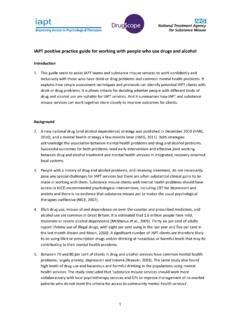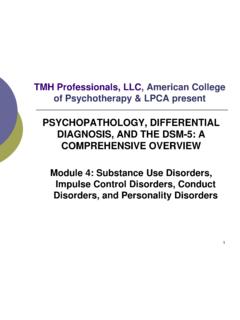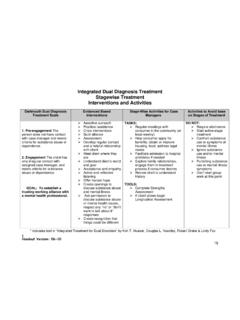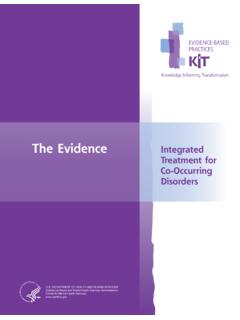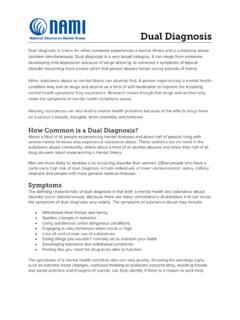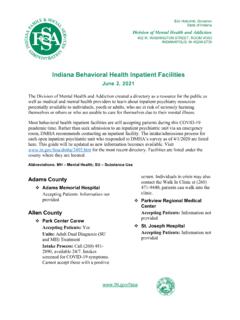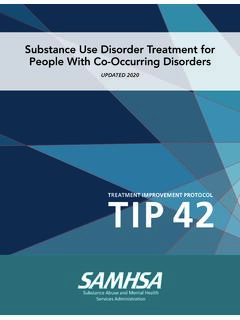Transcription of Mental health and substance misuse
1 1 Mental health and substance misuse On behalf of the Recovery Partnership 2 substance misuse substance misuse indicates consumption of psychoactive and intoxicant substances, legal and illegal, at a level which is harmful and/or problematic. This is used in preference to dependence or dependent, which would exclude problematic use where no physical or psychological dependence has occurred, and addiction, which many people feel to be stigmatising and pejorative. Where dependence is used, it should be taken to mean precisely that. Coexisting Mental ill health and substance misuse disorder - dual diagnosis The terms multiple needs and comorbidity are used to indicate coexisting conditions of substance use combined with Mental health problems; a co-morbidity that may describe the majority of people in treatment for drug and/or alcohol use and a significant minority of people accessing statutory Mental health services.
2 This condition of coexisting needs is often referred to as dual diagnosis . While this broad definition is sufficient for the purpose of this briefing, the Department of health offers a more nuanced definition, which is considered in this briefing. Recovery In the context of substance use, the term recovery indicates the sense in which that term is used in the 2010 Drug Strategy: that it is an individual, person-centred journey and that it is a process Definitions 3 rather than an end state. As such, the intention is that the use of the term recovery is not indicative of any particular approach, such as medically assisted recovery or abstinence based treatment. Concepts of recovery, including differences and similarities between the fields of Mental health and substance use are discussed in more detail elsewhere in this briefing.
3 dual diagnosis The particular focus of this report is on the intersection and relationship between coexisting Mental ill health and substance misuse . In 2001-2, the Comorbidity of substance misuse and Mental illness Collaborative (COSMIC) study team conducted a cross-sectional prevalence survey in 4 urban locations: the London boroughs of Brent and Hammersmith & Fulham, plus inner-city locations in Nottingham and Sheffield. Their findings suggest that comorbidity or dual diagnosis is extensive across all the services included in this research: Community Mental health Teams (CMHTs) and (statutory) drug services and alcohol services, where comorbidity is essentially the norm. The findings included the discovery that: For clients of drug services, 75% had experienced a psychiatric disorder in the last year; For clients of alcohol services, 85% had experienced a psychiatric disorder in the last year; 4 For clients of CMHTs, 44% had experienced problem drug use and/or harmful alcohol use in the past year; Of clients of drug and alcohol services with comorbidity, reported contact with psychiatric services.
4 Clients of London CMHTs were more likely than those elsewhere to use drugs; this was statistically significant and was attributed by the researchers to the higher general prevalence of substance use in London. There was no significant difference in respect of alcohol, although in total, over half of the CMHT patients in London had used substances harmfully or problematically in the past year. The researchers found that for many of the CMHT patients, there was limited prospect of successful referral to a drug (rather than an alcohol) service, although it should be noted that this was under the prevailing access criteria of the time and would in most cases not apply if the exercise was repeated today. This illustrates the point in the opening quote in this report; that when such a large proportion of a service s clients present with complex needs, thinking about meeting those needs through something additional or bolted on to the core service offer is unlikely to meet the needs of all clients and patients.
5 While the understanding of dual diagnosis as diagnoses of substance use and Mental ill health coexisting simultaneously is widely understood, the Department of health (with the Ministry of 5 Justice) provides a more nuanced typology of four definitions, all meeting the criteria of dual diagnosis : A primary Mental health problem that provokes the use of substances. For example, someone suffering from schizophrenia who finds that heroin reduces some of his or her symptoms; substance misuse and/or withdrawal leading to psychiatric symptoms or illnesses. For example, the emergence of depression post-detoxification including insomnia and low mood, or the emergence of a psychiatric disorder that to which the individual was vulnerable pre- substance misuse ; A psychiatric problem that is worsened by substance misuse .
6 For example, a person with heightened anxiety of danger from others, who uses cannabis to relax, but finds that the cannabis can increase their paranoia, leading to increased alienation; substance misuse and Mental health problems that do not appear to be related to one another. For example, someone who has an ongoing anxiety problem that is neither lessened nor worsened by drug and/or alcohol However, it should be noted that the term dual diagnosis may bring additional problems alongside ones of definition. The term arguably further stigmatises a cohort already subject to 6 significant levels of discrimination and there is also the technical but important point that many people that practitioners might describe the term applying to will, in fact, not have had any formal 7 The issue of complex needs and how to best meet the challenges posed arguably falls into the definition of a wicked problem.
7 Wicked problems occur in situations where information is incomplete, where there are multiple actors who may have contradictory or incompatible attitudes or needs and when non-linear, holistic and big picture solutions may be required. However, while it is often more useful to think in terms of better or worse responses rather than right or wrong ones, wicked problems are not irresolvable problems. Innovation, flexibility, a commitment to continuous review and a willingness to work across organisational boundaries can all contribute to overcoming even the most significant obstacles. This briefing has several aims. These include: Introduction People with a dual diagnosis are, in effect, a kind of Mental health underclass. They find that their needs are not severe enough to meet the criteria of any single agency, so they can fall just below the threshold of all helping services.
8 Psychiatrist, quoted in Turning Point/Rethink toolkit When 80% of your clients have complex needs, talking about having dual diagnosis workers is the wrong way round. DrugScope/Recovery Partnership Mental health Summit participant 8 To outline the prevalence of dual diagnosis and multiple needs within the subject population and some of the consequences and causes of this; To provide an overview of where progress has been made and where it has fallen short; To consider the role of Mental health services and substance use services as part of a network of potential and actual support providers; To give consideration to dual diagnosis and complex needs as one factor in a system of often self-reinforcing exclusions and characteristics.
9 To consider four areas where there is either clear potential for progress or else potential for retrograde developments, focussing on the 2002 dual diagnosis Guidelines and the proposed review; complex needs and offending, complex needs and young people, and how people with histories affected by complex needs can build a better life for themselves; To offer a limited number of practical recommendations for services as well as for central and local government. 9 2002 - Mental health Policy Implementation Guide: dual diagnosis Good Practice Guide The first national guidance concerning the treatment of people affected by dual diagnosis was produced by the Department of health in The guidance summarises (then) current policies and emerging good practice in the provision of Mental health services to people with severe Mental health problems and problematic substance misuse .
10 Written primarily from the perspective of integrating treatment for those affected by severe and enduring Mental health problems within a Mental health setting, it also provided more general guidance for the design and delivery of services for people affected by coexisting substance misuse and Mental ill health elsewhere on the spectrum of need. The guidance states unambiguously that: substance misuse is usual rather than exceptional amongst people with severe Mental health problems and the relationship between the two is complex. Individuals with these dual problems deserve high quality, patient focused and integrated care. This should be delivered within Mental health services. [Emphasis in original]. This policy is referred to as mainstreaming.
